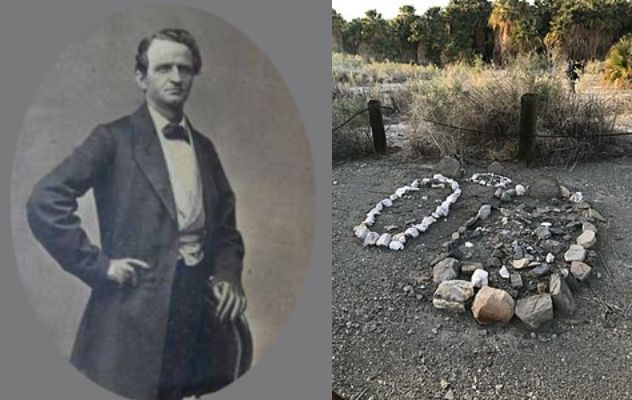 Weird Stuff
Weird Stuff  Weird Stuff
Weird Stuff  Our World
Our World 10 Ways Your Christmas Tree Is More Lit Than You Think
 Movies and TV
Movies and TV The 10 Coolest Stars to Set Sail on The Love Boat
 History
History 10 Things You Didn’t Know About the American National Anthem
 Technology
Technology Top 10 Everyday Tech Buzzwords That Hide a Darker Past
 Humans
Humans 10 Everyday Human Behaviors That Are Actually Survival Instincts
 Animals
Animals 10 Animals That Humiliated and Harmed Historical Leaders
 History
History 10 Most Influential Protests in Modern History
 Creepy
Creepy 10 More Representations of Death from Myth, Legend, and Folktale
 Technology
Technology 10 Scientific Breakthroughs of 2025 That’ll Change Everything
 Weird Stuff
Weird Stuff Ten Bizarre Facts About The Doge Meme
 Our World
Our World 10 Ways Your Christmas Tree Is More Lit Than You Think
 Movies and TV
Movies and TV The 10 Coolest Stars to Set Sail on The Love Boat
Who's Behind Listverse?

Jamie Frater
Head Editor
Jamie founded Listverse due to an insatiable desire to share fascinating, obscure, and bizarre facts. He has been a guest speaker on numerous national radio and television stations and is a five time published author.
More About Us History
History 10 Things You Didn’t Know About the American National Anthem
 Technology
Technology Top 10 Everyday Tech Buzzwords That Hide a Darker Past
 Humans
Humans 10 Everyday Human Behaviors That Are Actually Survival Instincts
 Animals
Animals 10 Animals That Humiliated and Harmed Historical Leaders
 History
History 10 Most Influential Protests in Modern History
 Creepy
Creepy 10 More Representations of Death from Myth, Legend, and Folktale
 Technology
Technology 10 Scientific Breakthroughs of 2025 That’ll Change Everything
Ten Lesser-Known Unsolved Disappearances and Murders
It’s natural to want justice for a crime as serious as homicide or as confusing as a disappearance. Police departments put incredible resources into solving crimes like these. Victims’ families take solace in whatever closure is offered by a guilty conviction or even just a definitive answer. The loss can never be replaced, but society moves forward when the justice system functions as it should.
But sometimes, this doesn’t happen. Unsolved homicides and disappearances leave incredible grief for loved ones seeking answers. Cases go cold, leads dry up, and decades later, there are still no answers. These ten cases may not be as well-known, but they are among America’s oldest unsolved crimes and disappearances.
Related: 10 Expeditions That Mysteriously Disappeared
10 Herman Ehrenberg: A 156-Year-Old Cold Case

Photo credit: Wikimedia Commons
Herman Ehrenberg was a German immigrant who made good in America. The Prussian-born man fought against Mexico in the Texas Revolution and then trekked west, working as a surveyor and miner. He eventually made a fortune in the Gold Rush of the mid-19th century. In October 1866, he traveled from Yuma, Arizona, to southern California on a stagecoach. He intended to buy a mine in the San Bernardino area, so he brought thousands of dollars worth of gold to make the purchase.
On the night of October 9, he stopped to rest in the settlement of Dos Palmas southeast of Palm Springs, deciding to sleep overnight on a pallet outside the stagecoach station. In the middle of the night, station master W.H. Smith heard a gunshot. He ran outside and found Ehrenberg dying from a bullet wound. The gold in his pockets was gone, and the killer had fled. Some residents wondered if a member of the local Cahuilla Indian Tribe was responsible. Years later, others suggested Smith was the one who robbed and killed Ehrenberg. Whatever really happened will likely never be known.[1]
9 Nels and Annie Anderson: A Century-Old Mystery
The night of December 7, 1924, was supposed to be just like any other for Nels and Annie Anderson. The 43-year-old man and his 39-year-old wife owned a barbershop on Minnesota Avenue in Billings, Montana. When closing time came, the pair cleaned the place and grabbed their coats to leave. They never made it out the door. The next day, police found Nels and Annie hacked to death inside the shop. The murder weapon was an ax the pair kept inside the store to split wood for heat.
The authorities found no sign of a break-in, no robbery, or any other sign of struggle. Police thought the couple was on their way out when they were surprised by the killer. Inside, the scene was grisly. Cops believed the killer rinsed their blood off his hands in the shop’s wash basin, but investigators couldn’t find any fingerprints. Vexed cops combed through the couple’s letters and interrogated friends. Through it all, they couldn’t find anyone who wanted to inflict harm on the pair. No arrests were ever made. Nearly 100 years later, the identity of the murderer is still unknown.[2]
8 Olga Mauger: Victim or Runaway?
Olga Mauger was 21 years old when she wed wealthy Wyoming oil magnate Carl Mauger in August 1934. The pair only knew each other for a few weeks before their marriage. Almost immediately, Olga regretted it. That fall, she wrote to her sister about being unhappy with Carl. Still, nobody expected what would happen next.
Late in 1934, the couple was hiking in the wilderness near Dubois, Wyoming, in search of elk. The newlyweds were both experienced outdoor hunters and trappers. So when Olga told Carl she wanted to rest, he left her alone with a hatchet and a bag of food. Not worried about his capable wife, Carl hiked ahead on his own. When he returned less than an hour later, Olga was gone.
Carl knew something was wrong. He insisted to local newspapers that his wife would not have gotten lost in the woods she knew so well. He rushed to put together a search party of 300 men. The group fanned out to look all over the area but turned up nothing. After several days, a bad snowstorm stopped their search. Olga was never seen again, and no trace of her has ever been found.[3]
7 Cathy Moulton: Disappearance in the Maine Woods
Cathy Moulton was excited about a YMCA dance in Portland, Maine, in the fall of 1971. On the afternoon of September 24, the 16-year-old asked her parents if she could go downtown to buy a pair of tights for the dance. Her father drove Cathy downtown and dropped her off. The teen bought the tights, and on the way out, she saw a friend. The two went to a nearby record store for a bit before Cathy left to walk home around 5:30 pm. She never made it.
Portland cops initially thought Cathy’s disappearance was a teenage runaway case. But her parents knew something was wrong. Days later, a lead came in about a girl said to resemble Cathy—she was seen in a car with a boy that night. Police couldn’t figure out the boy’s identity, though. The case went cold from there. More than a decade later, a hunter in rural Maine claimed he found human remains with 1970s-style women’s clothes. He reported it to the police, but when they trekked back to the area, he couldn’t locate the scene again. A search of the area in 2004 couldn’t find the remains, either.
Even after more than 50 years, Cathy’s disappearance has never been solved.[4]
6 Beth van Zanten: Victim of a Serial Killer?
Two brothers were enjoying the great outdoors in Anchorage, Alaska, on Christmas Day 1971 when they found the corpse of a woman in a local park. She was naked below the waist, her chest was slashed, and her hands were tied with wire. Cops searched missing persons’ reports and learned the woman was Celia “Beth” van Zanten. Beth was an 18-year-old who had been reported missing two days earlier after vanishing on a trip to a local store. The case took another turn when forensic investigators discovered the reason Beth perished: she froze to death.
Detectives realized she had somehow slipped free from her attacker during the assault. While escaping, she likely fell from a ledge in the park. Injured, tied up, and half-naked, she froze. Police interviewed van Zanten’s family and friends but couldn’t come up with a suspect. Eventually, cops suspected serial killer Robert Hansen was the attacker. He admitted to killing 17 women across Alaska in the 1970s and 1980s. But despite his willingness to discuss his murders, Hansen never admitted to van Zanten’s death. It has remained a mystery ever since.[5]
5 Annita Price: Green Gremlin Disappearance
On the night of May 30, 1974, Annita Price left her apartment for work in Benwood, West Virginia. Witnesses took notice of the memorable car: a green AMC Gremlin. But when the dependable woman never showed up for work, her employer became suspicious. The next morning, the car was found on the side of the highway in the neighboring town of McMechen. Price was gone, but her wallet and purse were both inside the car, and makeup was spread across the front seat.
Local police were slow to investigate her disappearance, and potentially valuable time was lost. When cops did look into the situation, they questioned her ex-husband. At the time, the two were going through a divorce and custody battle. Detectives never found evidence to link the man to her disappearance, though. Decades later, an anonymous informant told police Price had been shot to death and buried. The story was never confirmed, but it was enough to reopen the case in 2009. Sadly, recent searches have failed to turn up any new information or solve this decades-old disappearance.[6]
4 Alvin Matlock: 70-Year-Old Washington Mystery

Photo credit: Wikimedia Commons
Alvin Matlock was a veteran of the U.S. Army trying to make his way in the Pacific Northwest in 1951. That year, the young man known to friends as “Bud” struck out on his own in a cabin outside the city of Spokane, Washington. In March, he spoke to family members and informed them of his location. A loner and an outdoorsman, he went about his business from there. But family members were concerned when he didn’t show up to Thanksgiving dinner seven months later.
His mother visited the cabin and found it uninhabited. So, she reported him missing. The police didn’t have much to go on. Nobody even knew when Matlock had disappeared over the preceding seven months. Innocuous reports suggested he had quietly moved to Alaska. Darker rumors swirled that he was shot to death by the husband of a woman with whom he’d been having an affair. Cops suspected foul play, but no leads ever panned out. Matlock simply vanished. His disappearance has never been solved.[7]
3 The Capital City Killings
It’s especially unsettling to see a serial killer’s crimes go unpunished. But that’s exactly what police in Madison, Wisconsin, think happened fifty years ago. Over a 14-year period from 1968 to 1982, the gruesome murders of seven women in the city went unsolved. All seven shared two notable characteristics: They were connected to the University of Wisconsin and had long hair parted in the middle.
In 1968, UW freshman Christine Rothschild was stabbed and strangled outside a dorm on campus. For almost a decade, her murder appeared to be an isolated incident. But in 1976, the killer struck again. Six women were killed over a six-year period through 1982 when Donna Mraz was stabbed to death outside the college’s football stadium. Witnesses heard her scream and saw the assailant run off, but they couldn’t identify him. Having been nearly caught may have scared him, and the murders stopped. Cops have come to believe all the murders were committed by the same man, but he has never been identified or brought to justice.[8]
2 Mary Virginia Carpenter: Gone for Almost 75 Years
Texas State College for Women student Mary Virginia Carpenter left her Texarkana home on June 1, 1948, to travel 200 miles back to school. When she got off the train in Denton, cab driver Edgar Ray “Jack” Zachary drove her to campus. He dropped her off around 9:00 pm, and Carpenter was never seen again.
Police immediately zeroed in on Zachary. Under interrogation, he claimed Carpenter walked to a car with two men inside after he dropped her off. Neither the car nor the men were ever identified. Zachary also said he went home after dropping her off. His wife corroborated that story, and the cabbie passed a polygraph test. Police turned to other suspects, even wondering if Carpenter was murdered by the Texarkana Phantom Killer after they learned she’d known three of his victims.
In 1957, Zachary was arrested on a separate assault charge, and his wife abruptly recanted her alibi from Carpenter’s 1948 case. Police put Zachary through another polygraph test, but he passed again. The cab driver died in 1984 without ever being charged. In 1998, fifty years after Carpenter’s murder, a man claimed he knew where her body was buried. Police excavated the site, but no remains were found.[9]
1 The Boy in the Box
Philadelphia police officers responded to an unforgettable call on February 26, 1957. Nearly 70 years later, they are still trying to find answers. That day, a college student found the body of a dead boy in a cardboard box. Forensic investigators responded and determined the boy had been between the ages of 4 and 6. He had blue eyes and brown hair. He was emaciated, beaten, and covered in bruises. Police didn’t know who he was and turned to the public for help. Philadelphia residents were horrified by the gruesome discovery.
Reporters seized on the story and named him “America’s Unknown Child” and “The Boy in the Box.” After the investigation went cold, the boy was buried in a city cemetery. Forty years later, his body was exhumed for DNA testing. The child was then reburied in a donated plot in a nicer cemetery. In 2020, civilian sleuths announced they were getting close to learning the boy’s identity. Sadly, over the next two years, the anniversary of his discovery came and went with mournful memorials but no definitive answers.[10]








